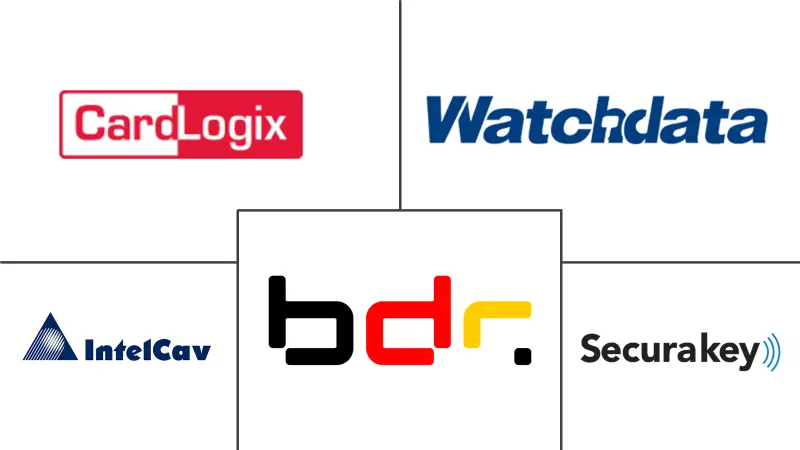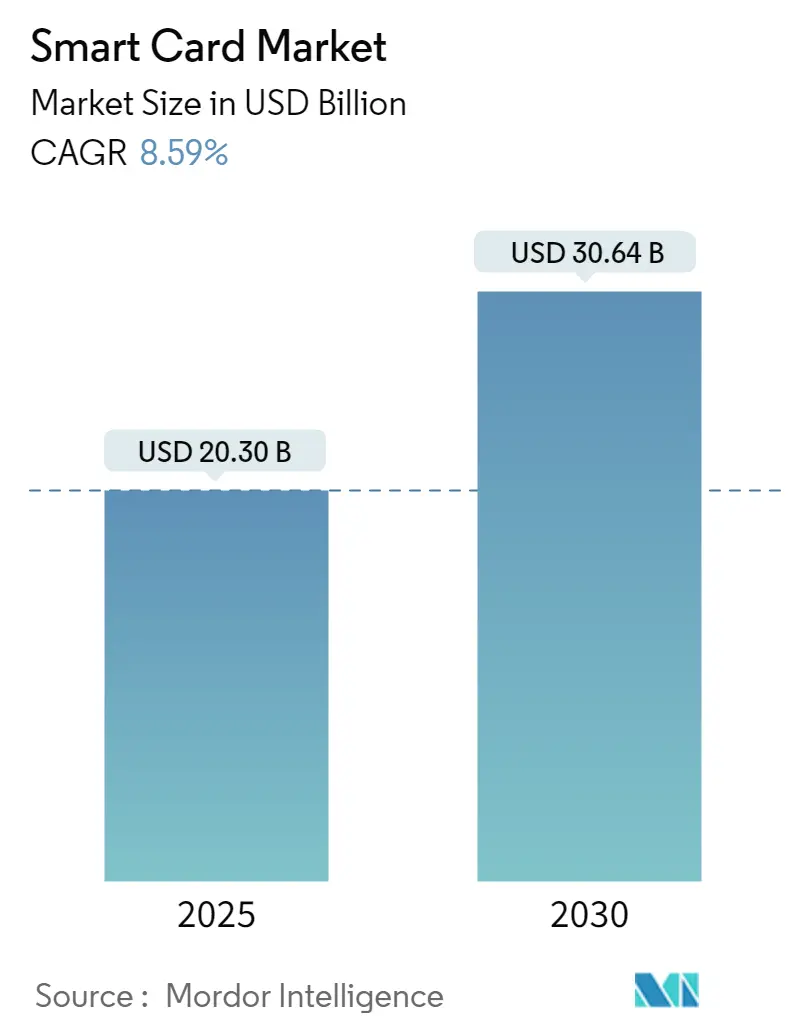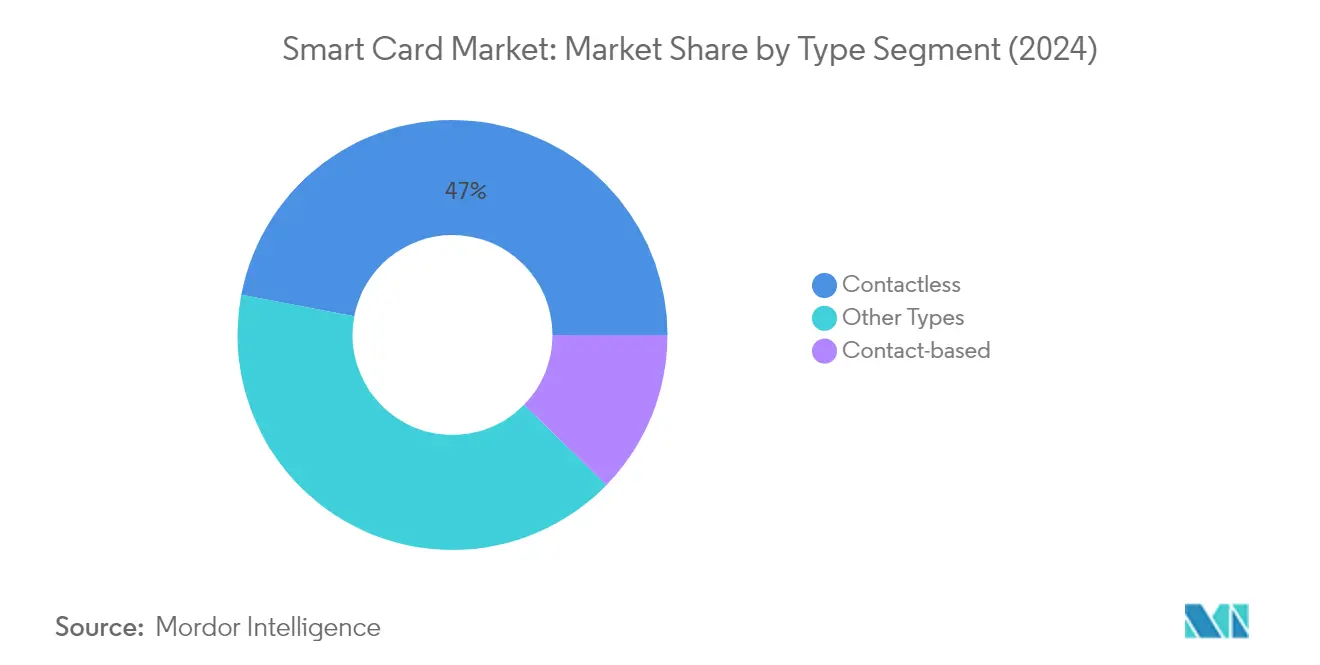Smart Card Market Analysis
The Smart Card Market size is estimated at USD 20.30 billion in 2025, and is expected to reach USD 30.64 billion by 2030, at a CAGR of 8.59% during the forecast period (2025-2030).
The smart card industry is experiencing rapid transformation driven by the convergence of digital security requirements and technological advancements across multiple sectors. Financial institutions and enterprises are increasingly prioritizing robust security frameworks to combat rising cybersecurity threats and fraud attempts. The healthcare sector particularly demonstrates this trend, with US health spending projected to reach nearly USD 6 trillion by 2027, creating substantial opportunities for secure digital identification and transaction solutions. The integration of smart card technologies with existing infrastructure has become crucial for organizations seeking to enhance their security protocols while maintaining operational efficiency.
The industry is witnessing significant technological convergence, with smart cards evolving beyond traditional authentication methods to incorporate advanced features like biometric verification and multi-factor authentication. According to UK Finance, 123 million of the United Kingdom's 159 million debit and credit cards now incorporate contactless technology, demonstrating the widespread adoption of advanced payment solutions. This evolution is particularly evident in the financial sector, where major payment networks like Mastercard and Visa report that approximately 63% of all transactions are now taking place at contactless-enabled merchants, highlighting the growing consumer preference for seamless payment experiences.
Infrastructure modernization initiatives across various sectors are driving the adoption of smart card solutions, particularly in urban mobility and public transportation systems. Notable developments include Miami's implementation of a contactless open fare payment system in 2023, allowing riders to access public transit through mobile phones, contactless bank cards, and wearable devices. Similar initiatives are being rolled out across major metropolitan areas globally, indicating a broader trend toward integrated smart city solutions that leverage smart card technologies for improved public services and urban mobility.
The market is experiencing rapid innovation in emerging applications, particularly in cryptocurrency and digital asset management. Strategic partnerships, such as the collaboration between CardLab and eSignus to develop cryptocurrency hardware wallet solutions in smart card form factors with biometric security features, exemplify this trend. These developments are expanding the traditional boundaries of smart card applications, creating new opportunities in digital identity management, secure access control, and financial services. The integration of Internet of Things (IoT) technologies with smart card solutions is further driving innovation, enabling more sophisticated and secure transaction mechanisms across various industries.
Smart Card Market Trends
Growing Deployment in Personal Identification and Access Control Application
The integration of advanced biometric technologies with smart cards has revolutionized personal identification and access control systems across various industries. According to the Biometrics Institute's 2022 survey, facial recognition emerged as the biometric technology expected to witness the most significant usage increase in the coming years, while fingerprint identification, being the most mature technology, was predicted to see modest growth with only 3% of respondents expecting significant increases. This trend has led to enhanced development of smart cards incorporating multiple biometric authentication methods, including fingerprint scanning, iris recognition, and facial recognition, providing organizations with robust security solutions that are virtually impossible to compromise.
The financial sector has been particularly proactive in adopting biometric smart cards for enhanced security and user authentication. For instance, in 2023, China Construction Bank (CCB) launched innovative biometric 'hard wallet' smart cards that enable secure digital currency transactions through fingerprint authentication. Similarly, the collaboration between MoriX Co. and Fingerprint Cards AB to develop and introduce biometric payment cards using the T-Shape module demonstrates the industry's commitment to advancing secure identification solutions. These implementations showcase how smart cards are evolving beyond traditional identification methods to become sophisticated security tools that combine multiple authentication factors while maintaining user convenience and privacy protection.
Growing Demand for Contactless Payments
The surge in demand for contactless smart card market solutions has become a significant driver for smart card market growth, with financial institutions and transportation systems leading the adoption. A notable example is the recent expansion of Octopus, a prominent smart card operator in Hong Kong, which extended its services to over 300 Chinese cities, enabling users to make contactless payments for various transportation modes, including buses, trains, and ferries. This implementation demonstrates the scalability and convenience of smart card-based payment systems, with initial top-up amounts reaching HKD 3,000 (USD 386) and plans for digital card integration in subsequent phases.
The banking sector has shown remarkable initiative in expanding contactless payment capabilities through smart cards, with several major institutions launching innovative solutions. In recent developments, banks such as Axis Bank, ICICI Bank, and SBM Bank have introduced new chip card solutions that combine enhanced security features with contactless payment capabilities. These implementations reflect the industry's response to growing consumer demand for convenient, secure, and touchless payment options. The integration of smart cards with mobile payment solutions and digital wallets has further enhanced their utility, allowing users to manage their transactions seamlessly across multiple platforms while maintaining robust security protocols.
Segment Analysis: By Type
Contactless Segment in Smart Card Market
The contactless smart card market continues to dominate the global smart card market, holding approximately 47% of the market share in 2024. This significant market position is driven by the increasing adoption of contactless payment solutions across various sectors, particularly in retail and public transportation. The segment's growth is further bolstered by the rising demand for secure and convenient payment methods, especially in developed regions like Europe and North America. Major financial institutions and transit authorities are increasingly implementing contactless smart card solutions to enhance customer experience and operational efficiency. The integration of advanced security features and the ability to support multiple applications on a single card have made contactless smart cards the preferred choice for both service providers and end-users.
Other Types Segment in Smart Card Market
The Other Types segment, which includes hybrid and dual interface cards, is projected to exhibit the strongest growth rate of approximately 7% during the forecast period 2024-2029. This remarkable growth is attributed to the increasing demand for versatile card solutions that can support both contact and contactless functionalities. The segment's expansion is driven by the growing need for multi-application cards in various sectors, including banking, healthcare, and government services. Financial institutions are particularly keen on adopting dual interface cards as they provide flexibility in payment methods while maintaining high security standards. The integration of biometric features and advanced encryption technologies in these cards is further accelerating their adoption across different end-user industries.
Remaining Segments in Smart Card Market by Type
The contact-based smart card segment, while representing a smaller portion of the market, continues to maintain its significance in specific applications where high security and direct interface are paramount. These cards are particularly valued in government identification, healthcare, and secure access control applications where physical contact with the reader is preferred for enhanced security. The segment's stability is supported by its established infrastructure and the continued reliance on contact-based authentication in certain critical applications. Despite the growing popularity of contactless solutions, contact-based smart cards remain essential in applications requiring the highest levels of security and authentication.
Segment Analysis: By End-User Industry
IT and Telecommunication Segment in Smart Card Market
The IT and Telecommunication segment dominates the global smart card market, holding approximately 30% market share in 2024. This significant market position is primarily driven by the extensive deployment of smart cards in telecommunications applications, particularly as Subscriber Identity Module (SIM) cards and Universal Integrated Circuit Cards (UICC) in mobile phones. The segment's dominance is further strengthened by the increasing adoption of NFC-enabled mobile phones incorporating secure elements for various applications, including mobile contactless payments, ticketing, and mobile marketing. Additionally, the exponential rise in mobile phone subscribers and the increasing penetration of mobile phones in emerging economies continue to fuel the demand for smart cards in this segment, with telecommunications companies leveraging smart card technology for secure authentication and service delivery.
Government Segment in Smart Card Market
The Government segment is projected to exhibit the highest growth rate of approximately 7% during the forecast period 2024-2029. This accelerated growth is attributed to increasing government initiatives worldwide focusing on digital identification systems and secure documentation. The segment's rapid expansion is driven by the growing adoption of smart cards for applications such as national ID cards, e-passports, driving licenses, and health cards across various countries. Government organizations are increasingly implementing smart card solutions to enhance security, reduce administrative costs, and improve service delivery efficiency. The integration of advanced features such as biometric authentication and multi-application capabilities in government-issued smart cards is further propelling the segment's growth.
Remaining Segments in Smart Card Market by End-User Industry
The other significant segments in the smart card market include BFSI, Retail, Healthcare, and other industries such as education, transportation, and entertainment. The banking smart cards market maintains a strong presence through the widespread adoption of EMV cards and secure payment solutions. The retail segment continues to evolve with the integration of loyalty programs and contactless payment solutions, while the healthcare smart card reader market leverages smart cards for patient identification and secure access to medical records. The transportation and education sectors within the other category are increasingly adopting smart card solutions for ticketing, access control, and campus management applications, contributing to the overall market dynamics.
Smart Card Market Geography Segment Analysis
Smart Card Market in North America
The North American smart card market holds a significant position globally, commanding approximately 24% of the global smart card market share in 2024. The region's market is primarily driven by the rapid adoption of contactless payment solutions across various sectors, particularly in retail and transportation. The United States plays a pivotal role in driving regional demand, supported by its developed infrastructure across various end-user industries. The region's growth is further bolstered by the increasing implementation of smart card technology in healthcare facilities to combat fraud and enhance security measures. Many government facilities and corporations have incorporated contactless readers for smart cards to provide secure access to operational facilities, while financial institutions continue to expand their contactless payment infrastructure. The market is also witnessing increased adoption of biometric smart cards, particularly in highly sensitive environments such as healthcare and behavioral health facilities.
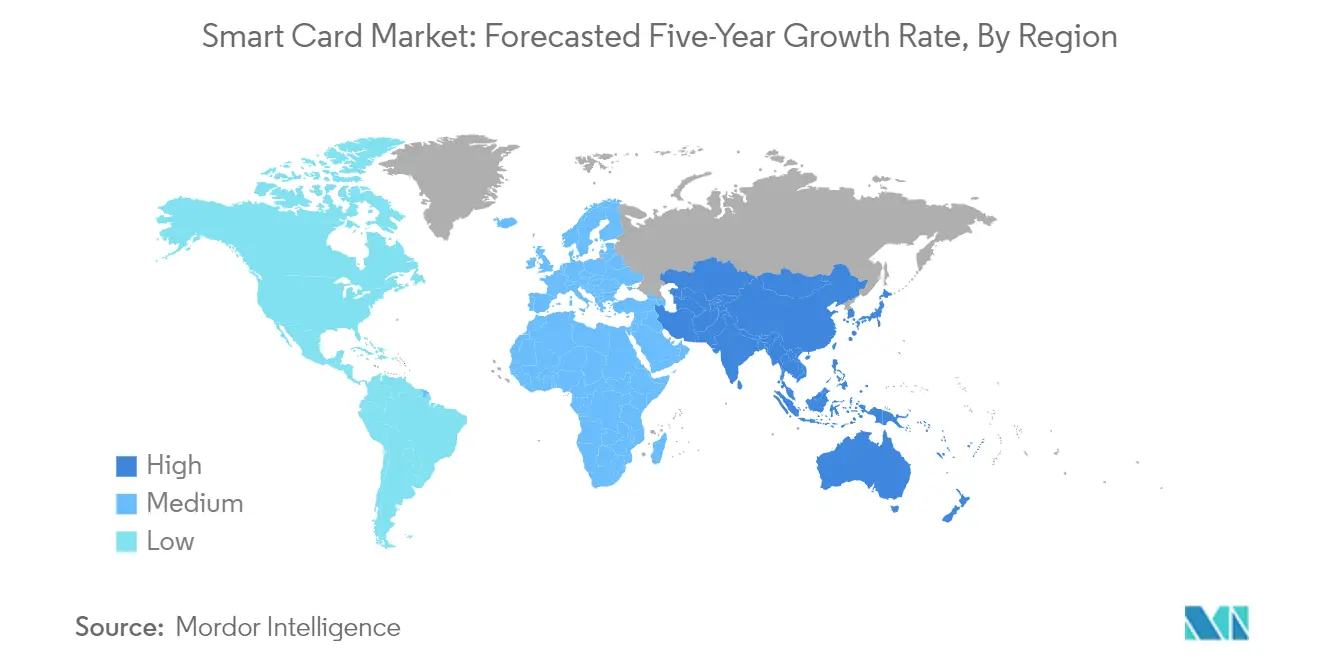
Smart Card Market in Europe
The European smart card market has demonstrated robust growth, recording an impressive expansion of approximately 33% from 2019 to 2024. The region's market is characterized by strong government initiatives focused on improving accessibility, affordability, and availability of healthcare through smart card implementation. European nations are at the forefront of creating secure and accessible systems that act as catalysts for digital transformation and business growth. The healthcare and health insurance systems in Europe are predominantly state-dominated, leading to widespread adoption of smart cards compared to other regions. The market is witnessing increased integration of advanced security technologies, particularly in the banking sector, with many financial institutions implementing sophisticated biometric verification systems. The region's commitment to digital identity management and secure payment solutions continues to drive innovation in smart card technologies, particularly in dual-interface and contactless payment solutions.
Smart Card Market in Asia-Pacific
The Asia-Pacific smart card market is positioned for substantial growth, with projections indicating a robust growth rate of approximately 7% during 2024-2029. The region stands as a powerhouse in smart card adoption, driven by rapidly digitalizing economies and strong government initiatives to incorporate smart chip-based systems. The market is characterized by innovative deployments across various sectors, particularly in public transportation and digital payment systems. Emerging economies in the region are actively developing robust financial systems that are increasingly digitized, creating substantial opportunities for smart card implementation. The region's market is particularly notable for its advanced adoption of contactless payment solutions and innovative applications in public transportation systems. The integration of smart cards with national identification systems and the growing emphasis on secure digital transactions continue to drive market expansion across various sectors.
Smart Card Market in Latin America
The Latin American smart card market represents a dynamic growth opportunity, emerging as a significant hub for smart card adoption and innovation. The region is experiencing rapid transformation in its payment infrastructure, with several countries implementing advanced smart card solutions across various sectors. The market is particularly active in government ID initiatives, driven by high-end national ID card deployments and continuous migration to e-passports. Mexico and Brazil lead the regional market, particularly in SIM card deployments and financial sector applications. The region's market is characterized by a gradual shift from cost-sensitive solutions to higher-end implementations with advanced security features and functionality. The adoption of EMV technology continues to expand across different countries, while government initiatives for secure identification and financial inclusion further drive market growth.
Smart Card Market in Middle East & Africa
The Middle East & Africa smart card market is experiencing significant transformation, driven by the region's push toward advanced technology and smart solutions. The market is characterized by diverse applications across healthcare, tourism, and telecommunications sectors. The region's governments are actively implementing smart card solutions for various applications, including national ID programs, healthcare services, and public transportation systems. The market is witnessing increased adoption of contactless payment solutions, particularly in the Gulf Cooperation Council (GCC) countries. The integration of smart card technology in government services and the growing emphasis on secure digital transactions are creating new opportunities for market expansion. The region's focus on smart city initiatives and digital transformation programs continues to drive the demand for sophisticated smart card solutions.
Smart Card Market in South Korea
The South Korean smart card market exemplifies technological advancement and widespread adoption across multiple sectors. The market is characterized by sophisticated implementation of smart card solutions in public transportation, banking, and educational institutions. The country's smart card ecosystem is particularly notable for its integration of multiple functionalities, allowing users to access various services with a single card. The market benefits from strong technological infrastructure and high consumer acceptance of digital payment solutions. Universities and educational institutions in South Korea have widely adopted multi-function smart cards for various applications, from identification to financial transactions. The country's emphasis on technological innovation and digital transformation continues to drive new applications and improvements in smart card technology.
Smart Card Industry Overview
Top Companies in Smart Card Market
The smart card market features prominent players like Thales Group, Giesecke & Devrient, IDEMIA, HID Global, and CPI Card Group leading innovation and market development. These smart card companies are heavily investing in research and development to create advanced solutions incorporating biometric authentication, contactless payment capabilities, and enhanced security features. Strategic partnerships with technology providers and financial institutions have become increasingly common to expand product offerings and market reach. Companies are focusing on developing sustainable and eco-friendly card solutions while simultaneously expanding their manufacturing capabilities across different regions. The industry is witnessing a strong push towards digital transformation with companies developing hybrid solutions that bridge physical cards with digital payment ecosystems. Operational agility has become crucial as manufacturers adapt to rapidly changing consumer preferences and technological standards, particularly in contactless payment solutions and mobile integration.
Consolidated Market with Strong Global Players
The smart card industry demonstrates a relatively consolidated structure dominated by large multinational conglomerates with diverse product portfolios spanning multiple industries. These established players leverage their extensive manufacturing capabilities, global distribution networks, and long-standing relationships with financial institutions and government bodies to maintain their market positions. The market has witnessed significant consolidation through strategic acquisitions, particularly as larger players seek to acquire specialized technology providers to enhance their digital capabilities and security solutions. Regional players maintain their presence through specialized offerings and strong local relationships, particularly in emerging markets where government ID projects and financial inclusion initiatives drive demand.
The industry landscape is characterized by high barriers to entry due to substantial technological requirements, stringent security certifications, and the need for significant capital investment in manufacturing infrastructure. Market leaders are increasingly focusing on vertical integration strategies, controlling everything from chip manufacturing to personalization services, which further strengthens their competitive position. The competitive dynamics are also shaped by the growing importance of value-added services and solutions beyond traditional card manufacturing, with companies developing comprehensive identity management and payment solutions platforms.
Innovation and Adaptability Drive Future Success
Success in the smart card market increasingly depends on companies' ability to anticipate and adapt to evolving technology trends while maintaining robust security standards. Market players must balance innovation with reliability, particularly as end-users demand more sophisticated features like biometric authentication and multi-application capabilities. The ability to offer customized solutions while maintaining cost-effectiveness has become crucial, especially in highly competitive segments like financial cards and government ID programs. Companies must also navigate the growing influence of digital alternatives while identifying opportunities to integrate traditional smart card solutions with emerging digital ecosystems.
Future market leadership will require strong investment in research and development, particularly in areas like contactless technology and mobile integration. Companies need to develop strong partnerships across the value chain, from chip manufacturers to system integrators, to deliver comprehensive solutions. The regulatory landscape, particularly around data protection and security standards, continues to shape market dynamics and create both challenges and opportunities for market players. Success will increasingly depend on the ability to maintain flexibility in manufacturing processes while ensuring compliance with evolving standards and regulations. Companies must also focus on developing sustainable solutions and maintaining strong relationships with key stakeholders in government and financial sectors. The smart card market share is likely to be influenced by these strategic initiatives.
Smart Card Market Leaders
-
CardLogix Corporation
-
Watchdata Technologies
-
Bundesdruckerei GmbH
-
IntelCav
-
Secura Key
- *Disclaimer: Major Players sorted in no particular order
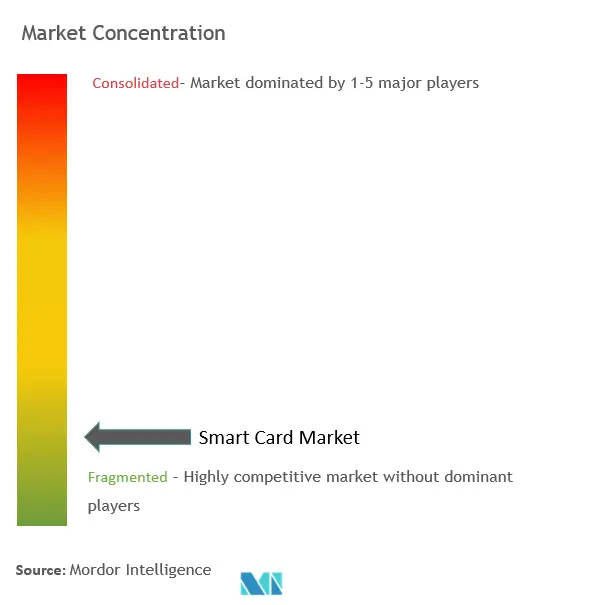
Smart Card Market News
- April 2023: The GoSmart National Common Mobility Card was launched for passengers using the Kanpur metro in India. The NCMC card was initially introduced in Uttar Pradesh by the Kanpur Metro. The primary advantage of this card is that it is an interchangeable transport card, meaning that it may be used for other NCMC-compliant retail, parking, metro, bus, and other transportation services throughout the nation. Travelers can easily traverse the entire nation with the NCMC card. Along with facilitating smooth mobility, this also helps travelers save time and energy.
- January 2023: A new innovation center dedicated solely to next-generation card technologies with a dedication to sustainability was inaugurated by dzcard, a prominent secured smart card solution and digital security provider in Southeast Asia. The Bangkok, Thailand lab will serve as a platform for co-creating goods with dzcard's clients and partners. The lab's focus is on creating and evaluating solutions and products that are sustainability-oriented.
Smart Card Market Report - Table of Contents
1. INTRODUCTION
- 1.1 Study Assumptions and Market Definition
- 1.2 Scope of the Study
2. RESEARCH METHODOLOGY
3. EXECUTIVE SUMMARY
4. MARKET INSIGHT
- 4.1 Market Overview
-
4.2 Industry Attractiveness - Porter's Five Forces Analysis
- 4.2.1 Bargaining Power of Suppliers
- 4.2.2 Bargaining Power of Buyers
- 4.2.3 Threat of New Entrants
- 4.2.4 Threat of Substitutes
- 4.2.5 Intensity of Competitive Rivalry
- 4.3 Industry Value Chain Analysis
- 4.4 Assessment of the Impact of COVID-19 on the Market
5. MARKET DYNAMICS
-
5.1 Market Drivers
- 5.1.1 Growing Deployment in Personal Identification and Access Control Applications
- 5.1.2 Extensive Use in Travel Identity and Transportation
- 5.1.3 Growing Demand for Contactless Payments
-
5.2 Market Restraints
- 5.2.1 Privacy and Security Issues and Standardization concerns
6. MARKET SEGMENTATION
-
6.1 By Type
- 6.1.1 Contact-based
- 6.1.2 Contact-Less
-
6.2 By End-user Vertical
- 6.2.1 BFSI
- 6.2.2 IT & Telecommunication
- 6.2.3 Government
- 6.2.4 Transportation
- 6.2.5 Other End-User Industries (Education, Healthcare, Entertainment, etc.)
-
6.3 By Geography
- 6.3.1 North America
- 6.3.1.1 United States
- 6.3.1.2 Canada
- 6.3.2 Europe
- 6.3.2.1 United Kingdom
- 6.3.2.2 Germany
- 6.3.2.3 France
- 6.3.2.4 Rest of Europe
- 6.3.3 Asia Pacific
- 6.3.3.1 China
- 6.3.3.2 Japan
- 6.3.3.3 India
- 6.3.3.4 Rest of Asia Pacific
- 6.3.4 Rest of the World
7. COMPETITIVE LANDSCAPE
-
7.1 Company Profiles
- 7.1.1 CardLogix Corporation
- 7.1.2 Watchdata Technologies
- 7.1.3 Bundesdruckerei GmbH
- 7.1.4 IntelCav
- 7.1.5 Secura Key
- 7.1.6 Alioth LLC
- 7.1.7 Gemalto NV (Thales Group)
- 7.1.8 Giesecke & Devrient GmbH (MC Familiengesellschaft mbH)
- 7.1.9 HID Global Corporation (Assa Abloy AB)
- 7.1.10 IDEMIA France SAS
- 7.1.11 Infineon Technologies AG
- 7.1.12 Fingerprint Cards AB
- 7.1.13 Samsung Electronics Co. Ltd
- 7.1.14 CPI Card Group Inc.
- 7.1.15 KONA I Co. Ltd
- *List Not Exhaustive
8. VENDOR POSITIONING ANALYSIS
9. INVESTMENT ANALYSIS
10. FUTURE OF THE MARKET
Smart Card Industry Segmentation
A smart card is a small plastic card embedded with an integrated circuit chip. It is capable of storing and processing data securely. Smart cards are used in various applications such as identification, authentication, payment systems, access control, and secure data storage.
The smart card market is segmented by type (contact-based and contactless), end-user vertical (BFSI, IT & telecommunication, government, transportation), and geography (North America [United States, Canada], Europe [United Kingdom, Germany, France, Rest of Europe], Asia Pacific [China, Japan, India, Rest of Asia Pacifi]), and Rest of the World). The market sizes and forecasts are provided in terms of value in USD for all the above segments.
| By Type | Contact-based | ||
| Contact-Less | |||
| By End-user Vertical | BFSI | ||
| IT & Telecommunication | |||
| Government | |||
| Transportation | |||
| Other End-User Industries (Education, Healthcare, Entertainment, etc.) | |||
| By Geography | North America | United States | |
| Canada | |||
| Europe | United Kingdom | ||
| Germany | |||
| France | |||
| Rest of Europe | |||
| Asia Pacific | China | ||
| Japan | |||
| India | |||
| Rest of Asia Pacific | |||
| Rest of the World | |||
Smart Card Market Research FAQs
How big is the Smart Card Market?
The Smart Card Market size is expected to reach USD 20.30 billion in 2025 and grow at a CAGR of 8.59% to reach USD 30.64 billion by 2030.
What is the current Smart Card Market size?
In 2025, the Smart Card Market size is expected to reach USD 20.30 billion.
Who are the key players in Smart Card Market?
CardLogix Corporation, Watchdata Technologies, Bundesdruckerei GmbH, IntelCav and Secura Key are the major companies operating in the Smart Card Market.
Which is the fastest growing region in Smart Card Market?
Asia Pacific is estimated to grow at the highest CAGR over the forecast period (2025-2030).
Which region has the biggest share in Smart Card Market?
In 2025, the North America accounts for the largest market share in Smart Card Market.
What years does this Smart Card Market cover, and what was the market size in 2024?
In 2024, the Smart Card Market size was estimated at USD 18.56 billion. The report covers the Smart Card Market historical market size for years: 2019, 2020, 2021, 2022, 2023 and 2024. The report also forecasts the Smart Card Market size for years: 2025, 2026, 2027, 2028, 2029 and 2030.
Our Best Selling Reports
Smart Card Market Research
Mordor Intelligence delivers comprehensive smart card industry analysis through detailed research and consulting expertise in the smart card market. Our extensive coverage includes various segments such as banking smart cards, EMV cards, and contactless smart card technologies. The report examines the evolving landscape of smart card usage across regions, focusing on emerging markets like smart cards India. Our analysis provides a detailed evaluation of smart card IC technologies and chip card innovations. This information is available in an easy-to-download report PDF format.
The report offers stakeholders actionable insights into smart card development and future trends. It analyzes the performance of leading smart cards companies. Our research covers crucial aspects, including healthcare smart card reader applications and smart card size specifications. The smart card market forecast presents detailed projections based on current market dynamics and emerging opportunities. The report offers invaluable insights for decision-makers, including a comprehensive analysis of powered smart card technologies and secure digital card implementations. This enables stakeholders to make informed strategic decisions in this rapidly evolving industry.

